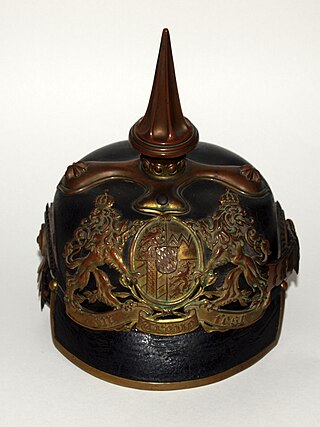
The Pickelhaube, also Pickelhelm, is a spiked leather or metal helmet that was worn in the 19th and 20th centuries by Prussian and German military officers, firefighters and police. Although it is typically associated with the Prussian Army, which adopted it in 1842–43, the helmet was widely imitated by other armies during that period. It is still worn today as part of ceremonial wear in the militaries of certain countries, such as Sweden, Chile, and Colombia.

Moldavia is a historical region and former principality in Central and Eastern Europe, corresponding to the territory between the Eastern Carpathians and the Dniester River. An initially independent and later autonomous state, it existed from the 14th century to 1859, when it united with Wallachia as the basis of the modern Romanian state; at various times, Moldavia included the regions of Bessarabia, all of Bukovina and Hertsa. The region of Pokuttya was also part of it for a period of time.

Wallachia or Walachia is a historical and geographical region of Romania. It is situated north of the Lower Danube and south of the Southern Carpathians. Wallachia is traditionally divided into two sections, Muntenia and Oltenia. Dobruja could sometimes be considered a third section due to its proximity and brief rule over it. Wallachia as a whole is sometimes referred to as Muntenia through identification with the larger of the two traditional sections.

A boyar or bolyar was a member of the highest rank of the feudal nobility in many Eastern European states, including Kievan Rus', Bulgaria, Russia, Wallachia and Moldavia, and later Romania, Lithuania and among Baltic Germans. Boyars were second only to the ruling princes from the 10th century to the 17th century. The rank has lived on as a surname in Russia, Finland, Lithuania and Latvia where it is spelled Pajari or Bajārs/-e.
The Middle Ages in Romania began shortly after the withdrawal of the Roman legions from the former Roman province of Dacia in the late 3rd century and with the start of the Early Middle Ages and the Migration Period that followed afterwards respectively. It subsequently came to an end with the reign of Domn Michael the Brave (1593–1601) who managed, for a short time between 1599 and 1600, to rule Wallachia, Moldavia, and Transylvania together, the three principalities whose territories were to be united some three centuries later to form modern and contemporary Romania.

Lupu Coci, known as Vasile Lupu, was a Voivode of Moldavia of Albanian origin between 1634 and 1653. Lupu had secured the Moldavian throne in 1634 after a series of complicated intrigues and managed to hold it for twenty years. Vasile was a capable administrator and a brilliant financier and was soon almost the richest man in the Christian East. His gifts to Ottoman leaders kept him on good terms with the Ottoman authorities.

Prince Barbu Alexandru Știrbey was 30th Prime Minister of the Kingdom of Romania in 1927.
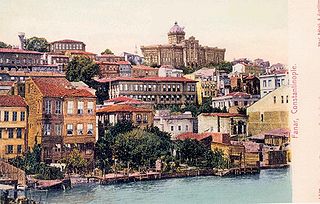
Phanariots, Phanariotes, or Fanariots were members of prominent Greek families in Phanar, the chief Greek quarter of Constantinople where the Ecumenical Patriarchate is located, who traditionally occupied four important positions in the Ottoman Empire: Voivode of Moldavia, Voivode of Wallachia, Grand Dragoman of the Porte and Grand Dragoman of the Fleet. Despite their cosmopolitanism and often-Western education, the Phanariots were aware of their Greek ancestry and culture; according to Nicholas Mavrocordatos' Philotheou Parerga, "We are a race completely Hellenic".

The Russian nobility arose in the Middle Ages. In 1914 it consisted of approximately 1,900,000 members in the Russian Empire.
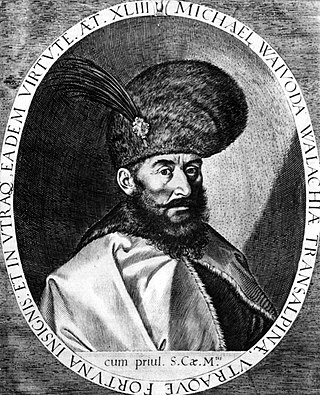
Michael the Brave, born as Mihai Pătrașcu, was the Prince of Wallachia, Prince of Moldavia (1600) and de facto ruler of Transylvania. He is considered one of Romania's greatest national heroes. Since the 19th century, Michael the Brave has been regarded by Romanian nationalists as a symbol of Romanian unity, as his reign marked the first time all principalities inhabited by Romanians were under the same ruler.
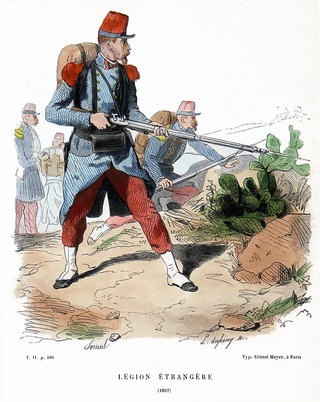
A casquette d'Afrique was a type of lightweight military headgear generally used by the French metropolitan and colonial armies from the early 1830s to the 1860s.
The Early Modern Times in Romania started after the death of Michael the Brave, who ruled in a personal union, Wallachia, Transylvania, and Moldavia – three principalities in the lands that now form Romania – for three months, in 1600. The three principalities were subjected to the Ottoman Empire, and paid a yearly tribute to the Ottoman Sultans, but they preserved their internal autonomy. In contrast, Dobruja and the Banat were fully incorporated into the Ottoman Empire.
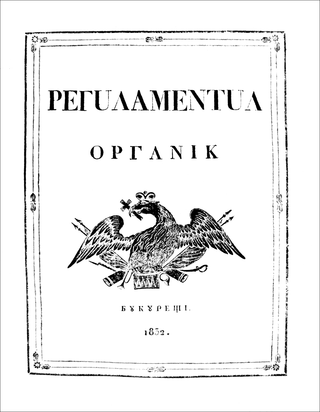
Regulamentul Organic was a quasi-constitutional organic law enforced in 1831–1832 by the Imperial Russian authorities in Moldavia and Wallachia. The document partially confirmed the traditional government and set up a common Russian protectorate which lasted until 1854. The Regulamentul itself remained in force until 1858. Conservative in its scope, it also engendered a period of unprecedented reforms which provided a setting for the Westernization of the local society. The Regulamentul offered the two Principalities their first common system of government.

The uprising of 1821 was a social and political rebellion in Wallachia, which was at the time a tributary state of the Ottoman Empire. It originated as a movement against the Phanariote administration, with backing from the more conservative boyars, but mutated into an attempted removal of the boyar class. Though not directed against Ottoman rule, the revolt espoused an early version of Romanian nationalism, and is described by historians as the first major event of a national awakening. The revolutionary force was centered on a group of Pandur irregulars, whose leader was Tudor Vladimirescu. Its nucleus was the Wallachian subregion of Oltenia, where Vladimirescu established his "Assembly of the People" in February.
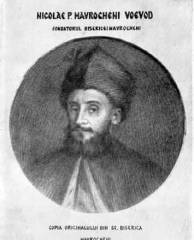
Nicholas Mavrogenes, was a Phanariote Prince of Wallachia. He was the great-uncle of Manto Mavrogenous, a heroine of the Greek War of Independence.
Albanians in Romania are an officially recognized ethnic minority, with one seat reserved in the Romanian Chamber of Deputies to the League of Albanians of Romania.

Slavery existed on the territory of present-day Romania from the founding of the principalities of Wallachia and Moldavia in 13th–14th century, until it was abolished in stages during the 1840s and 1850s before the Romanian War of Independence and the formation of the United Principalities of Moldavia and Wallachia in 1859, and also until 1783 in Transylvania and Bukovina. Most of the slaves were of Romani ethnicity. Particularly in Moldavia there were also slaves of Tatar ethnicity, probably prisoners captured from the wars with the Nogai and Crimean Tatars.

The boyars of Moldavia and Wallachia were the nobility of the Danubian Principalities of Moldavia and Wallachia. The title was either inherited or granted by the Hospodar, often together with an administrative function. The boyars held much of the political power in the principalities and, until the Phanariote era, they elected the Hospodar.

Leon Tomșa, also known as Leon Vodă or Alion, was the Prince of Wallachia from October 1629 to July 1632. He claimed to be a son of Ștefan IX Tomșa, and as such a Moldavian, but was generally identified as a Greek of lowly origins, and reportedly an oyster-monger. He was imposed on the throne by the Ottoman Empire, one of a line of Princes who were primarily subservient to Ottoman power. In his first year, he also supported the political ascendancy of Greeks and Levantines, many of whom made their way into Wallachia's traditional aristocracy, or boyardom. This upset the local boyars, who were further alienated and impoverished by Leon's fiscal policies, which in turn reflected Ottoman demands for tribute. The regime was threatened by an Oltenia-centered rebellion, initially led by Ban Aslan, and later by Matei Basarab. Though often depicted as an anti-Greek movement, it had Greeks and Romanians fighting on either side.

The Paharnic was a historical Romanian rank, one of the non-hereditary positions ascribed to the boyar aristocracy in Moldavia and Wallachia. It was the local equivalent of a cup-bearer or cześnik, originally centered on pouring and obtaining wine for the court of Moldavian and Wallachian Princes. With time, it became a major administrative office and, in Wallachia, also had a lesser military function. The retinue of such boyars, usually called Păhărnicei, was in both countries also a private army.

















